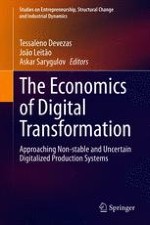This book takes an in-depth look at the economics of digital transformation. Presenting a variety of perspectives from experts, it deals with the socioeconomic changes associated with the digital transformation of production systems. The chapters also address the impacts of digital transformation on the sustainable functioning of socioeconomic and environmental systems. Select chapters also investigate the consequences of adopting intelligent learning systems, both in terms of replacing the human labor force. and their effects on the smart digital management and security of cities, places, and people. Lastly, chapters discuss important questions regarding innovations leading to sustainable change.
